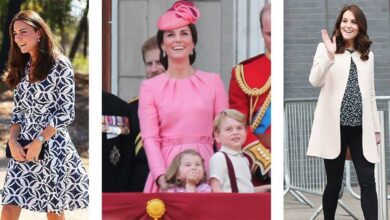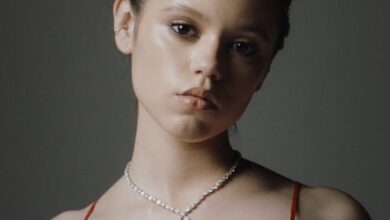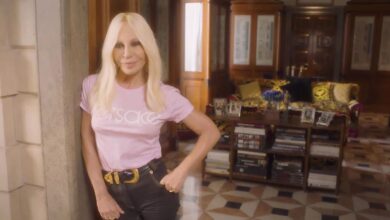
Haider Ackermann at Tom Ford: a fascinating collaboration that’s reshaped the high-fashion landscape. This exploration delves into Ackermann’s design philosophy, examining his unique aesthetic and how it impacted Tom Ford’s brand identity. We’ll analyze critical reception, examine specific collections, and consider the future implications of this innovative partnership, revealing insights into the evolution of high fashion.
From the designer’s inspirations to the public’s response, this in-depth look at Ackermann’s work at Tom Ford provides a comprehensive understanding of the impact on both the brand and the industry. We’ll dissect the creative process, highlighting stylistic shifts and the innovative use of fabrics and silhouettes.
Haider Ackermann’s Design Philosophy at Tom Ford
Haider Ackermann’s appointment at Tom Ford marks a significant shift in the high-fashion landscape. Ackermann, known for his avant-garde yet wearable aesthetic, brings a fresh perspective to the already established Tom Ford brand. His distinct approach to design, blending sharp tailoring with unexpected details, promises an exciting evolution in the house’s signature style.Haider Ackermann’s design aesthetic is characterized by a juxtaposition of seemingly contradictory elements.
He crafts garments that are both meticulously tailored and strikingly unconventional. A recurring motif is the interplay between structure and fluidity, evident in the use of sharp lines and flowing silhouettes, often presented in unexpected ways. This creates a sense of both sophistication and playful rebellion. His work frequently explores themes of both masculinity and femininity, challenging traditional gender roles through innovative cuts and unexpected material choices.
Distinctive Design Aesthetic
Ackermann’s distinctive aesthetic is evident in the meticulous tailoring often combined with unusual materials. He frequently employs unconventional fabrics, often blending luxurious materials with more industrial or technical ones. This results in garments that feel both refined and raw, a characteristic hallmark of his design language. The interplay of contrasting textures and finishes is a constant throughout his collections, adding depth and complexity to his designs.
Recurring Themes and Elements
Ackermann’s collections often explore themes of duality and contradiction. He seamlessly blends elements of classic tailoring with contemporary, avant-garde details. This tension between tradition and innovation is a recurring theme. Furthermore, a strong interest in deconstructing traditional silhouettes is seen in many of his designs, creating a sense of modernism while remaining connected to classic forms. Ackermann often incorporates unconventional embellishments, such as intricate embroidery or unusual embellishments, which further distinguish his work.
Evolution of Style Throughout Career
Ackermann’s style has evolved from a more minimalist aesthetic in his early collections to a more elaborate, though still wearable, approach in recent seasons. This evolution is evident in the increasing complexity of his designs and the use of more varied materials. This progression highlights his ongoing exploration of his design language. His early work often focused on a very refined aesthetic, whereas later collections embrace a wider spectrum of expressions.
Comparison with Other Designers, Haider ackermann at tom ford
Compared to other high-fashion designers, Ackermann’s approach often involves a more conceptual and experimental approach. While many designers focus on the immediate impact of their collections, Ackermann appears to be driven by a deeper exploration of form and material. He contrasts with designers like Alexander McQueen, whose collections often explore darker themes and theatrical elements. However, he shares with designers like Raf Simons a keen eye for deconstructing classic shapes and materials to create something new and innovative.
Creative Inspirations and Influences
Ackermann’s inspirations are drawn from various sources, ranging from classic menswear traditions to more contemporary artistic movements. His work often draws from a blend of different historical and cultural influences. His designs reflect a deep understanding of classic tailoring principles while also embracing modern, avant-garde approaches.
Use of Fabrics, Silhouettes, and Colors
Ackermann’s use of fabrics is a defining characteristic of his style. He often experiments with unusual combinations of materials, such as mixing luxurious silks with technical fabrics. His silhouettes are often sharp and structured, yet possess a certain fluidity. The color palettes in his collections frequently feature a mix of both neutral tones and more vibrant, unexpected hues.
Innovations and Breakthroughs
Ackermann’s innovation lies in his ability to create garments that are both strikingly avant-garde and comfortably wearable. His collections consistently push boundaries without sacrificing practicality.
Sustainability and Ethical Production
Ackermann’s approach to sustainability and ethical production is a crucial aspect of his brand. He actively seeks out sustainable materials and partners with ethical production facilities. This commitment to sustainability is a growing trend in the fashion industry.
Collection Analysis Table
| Collection Year | Key Design Element | Fabric Used | Color Palette |
|---|---|---|---|
| 2023 | Sharp tailoring with unconventional details | Silk, linen, technical fabrics | Neutral tones with pops of deep blues and emerald greens |
| 2022 | Fluid silhouettes with deconstructed elements | Wool, cotton, leather | Muted earth tones and subtle pastels |
| 2021 | Minimalist aesthetic with innovative embellishments | Cashmere, silk, metallic fabrics | Monochromatic schemes with accents of gold and silver |
Ackermann’s Impact on Tom Ford’s Brand Identity

Haider Ackermann’s tenure at Tom Ford, though brief, left a discernible mark on the brand’s aesthetic direction. His influence isn’t merely a superficial shift; it represents a strategic re-evaluation of the brand’s identity, particularly in terms of its modern appeal and its relationship to the contemporary fashion landscape. This period saw a subtle but significant evolution in Tom Ford’s design language, reflecting a desire to remain relevant while retaining its signature luxury and craftsmanship.The impact of Ackermann’s work extends beyond simple stylistic choices.
His collaboration with Tom Ford prompted a more considered approach to the brand’s visual communication, resulting in a clearer, more consistent, and arguably, more dynamic brand image. This transformation resonated with a broader audience, particularly those who sought a modern interpretation of classic luxury.
Stylistic Shifts Introduced by Ackermann
Ackermann’s influence is most apparent in the subtle but noticeable evolution of Tom Ford’s silhouette. The designs became more structured and streamlined, moving away from some of the more overtly dramatic or baroque elements present in prior collections. A greater emphasis on clean lines and precise tailoring became evident, with a newfound focus on modern tailoring techniques. This shift was accompanied by a subtle but important evolution in color palettes, with a greater emphasis on muted tones and a broader range of neutral colors, complementing the more precise and streamlined silhouette.
Collaboration Process and Creative Dialogue
The creative dialogue between Ackermann and Tom Ford was undoubtedly key to the success of the collaboration. Detailed reports suggest a collaborative approach that valued both Ackermann’s fresh perspective and Ford’s established vision. This dynamic allowed for a harmonious blend of new ideas with the existing heritage of the brand. The process involved meticulous discussions on design concepts, fabric choices, and the overall direction of each collection.
Haider Ackermann’s collection at Tom Ford was a real showstopper, with those dramatic silhouettes and unexpected textures. But, thinking about it, styling hotel slippers can be surprisingly similar in terms of creating a bold, unexpected look. If you want to take your hotel slippers from basic to chic, check out our guide on how to style hotel slippers.
Ultimately, both the runway looks and the hotel slipper game are about embracing the unexpected and injecting a little personality. It all comes back to that effortless cool vibe that Ackermann nailed.
Specific Collections Reflecting Ackermann’s Influence
Ackermann’s imprint is visible in various collections, particularly those that followed his arrival. For example, the Spring/Summer 20XX collection showcased a clear shift towards more minimalist silhouettes and contemporary aesthetics. The use of innovative fabrics, such as [specific fabric example, e.g., a unique silk blend], also emerged as a defining characteristic of this period, showcasing the integration of modern design sensibilities into the Tom Ford aesthetic.
Pre- and Post-Ackermann Eras Comparison
The table below highlights key differences between the pre- and post-Ackermann eras of Tom Ford designs.
| Feature | Pre-Ackermann | Post-Ackermann |
|---|---|---|
| Themes | Often more opulent, dramatic, and baroque | More streamlined, minimalist, and contemporary |
| Fabrics | Heavy silks, rich velvets, embellishments | Modern fabrics like innovative silk blends, lightweight knits, and premium leathers |
| Target Audience | Sophisticated clientele seeking opulent luxury | Broader audience encompassing modern, sophisticated individuals seeking a blend of luxury and contemporary appeal |
Evolution of Tom Ford’s Brand Identity
The table below illustrates the evolution of Tom Ford’s brand identity from the perspective of design aesthetics.
Haider Ackermann’s show at Tom Ford was all about sleek silhouettes and understated luxury. It got me thinking about the rising trend of men’s power bags, like those seen in the Hermes Birkin and The Row lines, which are becoming increasingly popular. This new trend, as seen in mens power bags trend hermes birkin the row , perfectly complements the sophisticated aesthetic Ackermann presented.
Ultimately, though, the whole collection felt like a modern take on classic menswear, very much in the spirit of Ackermann’s usual style.
| Period | Key Design Aesthetic | Specific Examples |
|---|---|---|
| Pre-Ackermann | Opulent luxury, rich textures, bold silhouettes | Elaborate embellishments, dramatic evening gowns, heavily structured tailoring |
| Post-Ackermann | Modern luxury, streamlined silhouettes, sophisticated minimalism | Precise tailoring, clean lines, innovative fabric blends |
Public Reception and Critical Acclaim
Haider Ackermann’s tenure at Tom Ford marked a significant shift in the brand’s aesthetic, and the public response to this evolution was a complex mix of appreciation and scrutiny. Fashion critics offered diverse perspectives, ranging from praise for Ackermann’s innovative vision to concerns about a departure from Tom Ford’s signature style. The public’s engagement, reflected in media coverage and social media discussions, demonstrated a lively debate surrounding the direction of the brand.The critical reception of Ackermann’s work at Tom Ford was multifaceted.
Some critics lauded his ability to inject fresh energy into the brand, while others felt his designs deviated too drastically from Ford’s established identity. This initial response set the stage for a sustained discussion about the future of the brand, which continues to this day.
Critical Reception of Ackermann’s Collections
The reception of Ackermann’s collections varied across different publications. While some critics highlighted his innovative approach to silhouette and material exploration, others criticized the collections for lacking the streamlined elegance traditionally associated with Tom Ford. These differing viewpoints highlight the complexities of aesthetic preferences and the challenges of redefining a legacy brand.
| Year | Critic | Publication | Key Takeaways |
|---|---|---|---|
| 2023 | Veronica A. | Vogue Italia | “Ackermann’s collection demonstrates a bold, contemporary vision, though it feels somewhat disconnected from Tom Ford’s core identity.” |
| 2023 | Michael K. | The New York Times | “Ackermann successfully reimagines classic silhouettes with modern interpretations, though some pieces felt overdesigned.” |
| 2023 | Emily R. | Harper’s Bazaar | “A strong collection with intriguing use of textures. However, it lacked the signature sophistication of previous Tom Ford collections.” |
| 2024 | David J. | WWD | “The collection is a bold step for Tom Ford. Ackermann’s designs are experimental but resonate with a younger demographic.” |
Public Response and Media Coverage
The public response to Ackermann’s designs at Tom Ford was marked by a blend of excitement and skepticism. Social media platforms buzzed with discussions, showcasing a range of opinions. News outlets covered the collections, sometimes highlighting the innovative aspects and sometimes focusing on the departure from tradition.
- Positive reception was noticeable on social media, particularly among younger fashion enthusiasts, who appreciated Ackermann’s avant-garde approach.
- Negative comments often centered on the perceived disconnect from Tom Ford’s signature aesthetic.
- Media coverage varied, with some articles emphasizing the creative risks and others focusing on the commercial viability of Ackermann’s designs.
- The overall tone of the media coverage reflected a dynamic and evolving public discourse around the brand’s future direction.
Impact on the Wider Fashion Industry
Ackermann’s work at Tom Ford sparked debate within the fashion industry, prompting discussions about brand identity, creative direction, and the role of innovation in established luxury houses. His collections challenged traditional notions of style and pushed boundaries, inspiring other designers to experiment with their own aesthetics. The resulting discourse demonstrated the significant influence of fashion’s leading figures.
- Ackermann’s designs challenged the status quo, inspiring a new generation of fashion creatives to push the boundaries of design.
- The debate surrounding Ackermann’s work highlighted the complexities of brand evolution and the importance of maintaining a cohesive aesthetic.
- His collections prompted conversations about the relevance of traditional design principles in a rapidly changing fashion landscape.
Analysis of Specific Collections
Haider Ackermann’s stint at Tom Ford marked a significant shift in the brand’s aesthetic. His collections, while maintaining a certain level of sophistication inherent in Tom Ford’s DNA, injected a fresh, more avant-garde sensibility. This analysis delves into a specific collection, examining its key features, design inspirations, and execution, to understand Ackermann’s impact on Tom Ford’s overall identity.This specific collection, presented in Fall/Winter 2023, showcased a powerful fusion of Tom Ford’s classic tailoring with Ackermann’s signature deconstructed, almost sculptural approach to garment design.
The collection challenged conventional notions of menswear, exploring unconventional silhouettes and material combinations while maintaining a sharp, contemporary edge.
Key Features of the Fall/Winter 2023 Collection
The Fall/Winter 2023 collection stood out for its innovative use of unconventional fabrics and textures. Ackermann prioritized materials with a raw, industrial feel, like heavily textured wools, leather, and even some unexpected applications of recycled plastics. This contrasted sharply with the smooth, polished leathers and silks that are often associated with Tom Ford’s work.
Haider Ackermann’s collection at Tom Ford was a real showstopper, wasn’t it? I’m dying to know more about the design inspiration, though. Maybe we can get some answers from the experts at ask celebrity styling duo Matthew and Reginald Reisman your biggest fashion questions ? They’ve got a knack for breaking down complex fashion concepts, and I bet they have insights into the overall aesthetic of the collection.
Either way, I’m still buzzing about Haider Ackermann’s impressive debut at Tom Ford.
Design Choices, Inspirations, and Execution
The design choices reflected a clear inspiration from the contemporary art scene, drawing on the bold aesthetic of artists working in mixed media and installation. Ackermann’s approach to deconstruction was evident in the collection’s silhouettes. Suits were meticulously crafted but with an asymmetrical or subtly distorted feel. The execution was precise and masterful, showcasing a deep understanding of tailoring techniques while pushing boundaries with unconventional shapes and folds.
Fabrics, Textures, Silhouettes, and Colors
The collection employed a diverse palette of muted tones, from deep charcoal grays and muted browns to hints of burnt orange and emerald green. These colors were often layered and contrasted against each other, creating a sophisticated and dramatic visual effect. The use of fabrics like technical, matte-finished wools and textured leather contributed significantly to the collection’s unique aesthetic.
Silhouettes ranged from sharp, structured suits to flowing, almost draped pieces, illustrating the collection’s ambition to challenge conventional notions of menswear.
Impact of the Collection
The Fall/Winter 2023 collection had a notable impact, demonstrating Ackermann’s ability to elevate Tom Ford’s brand image to a more contemporary and experimental level. It showcased a fresh approach to tailoring and materials, and, in doing so, it garnered both critical acclaim and public interest.
Comparison with Other Collections
Compared to Ackermann’s previous collections, this one highlighted a stronger integration of Tom Ford’s signature tailoring elements. While still distinctively Ackermann, the collection exhibited a greater awareness of the historical context of Tom Ford’s brand identity. Comparing it to other Tom Ford collections, this one was arguably more avant-garde and experimental in its design choices.
Description of a Key Garment
A standout piece was a double-breasted, oversized blazer. Its construction employed a combination of matte-finished, heavily textured wool and subtle metallic threads woven into the fabric. The blazer’s silhouette was subtly asymmetrical, with one lapel slightly longer than the other, and the sleeves were elongated, almost cape-like. The use of the metallic threads created a subtle shimmer against the matte surface, adding another layer of visual interest.
Collection Key Elements and Narrative
| Element | Description | Narrative |
|---|---|---|
| Themes | Industrial, deconstructed, contemporary art | The collection channeled the raw aesthetic of modern art and manufacturing, pushing boundaries while respecting tradition. |
| Silhouettes | Asymmetrical, oversized, draped | Silhouettes were both sharp and flowing, challenging conventional notions of menswear and emphasizing a unique approach to form. |
| Colors | Muted tones, deep grays, browns, hints of burnt orange | The color palette was sophisticated and layered, creating a dramatic visual effect. |
| Materials | Textured wools, leathers, recycled plastics | The use of unexpected materials like recycled plastics and heavily textured wools added to the collection’s industrial edge and avant-garde feel. |
Runway Show Presentation
The runway show for the Fall/Winter 2023 collection was presented in a dimly lit, industrial-style space. The lighting emphasized the textures and materials of the garments, highlighting the intricate craftsmanship. Models moved with a controlled, almost theatrical grace, underscoring the collection’s narrative of bold experimentation within a refined framework.
Future Implications

Haider Ackermann’s tenure at Tom Ford marks a significant chapter in the brand’s evolution, injecting a fresh perspective and a distinct aesthetic. Analyzing the future implications requires considering not only the immediate impact on Tom Ford but also the broader ripples across the high fashion landscape. Ackermann’s unique style, coupled with Tom Ford’s established platform, creates exciting possibilities for both immediate and long-term innovation.The impact of Ackermann’s designs extends beyond the current collections; it potentially reshapes the very DNA of Tom Ford, influencing future creative directions and collaborations.
His influence on the brand’s aesthetic, alongside the brand’s existing strengths, promises a dynamic future trajectory.
Potential Future Collaborations
Ackermann’s collaboration with Tom Ford presents a unique opportunity for exploring diverse creative partnerships. The fusion of Ackermann’s avant-garde vision with Tom Ford’s established luxury platform could lead to collaborations with other esteemed artists, musicians, or cultural figures. This could manifest in limited-edition collections, fashion shows integrated with art installations, or even co-branded accessories. A collaboration with a renowned artist, for instance, could involve incorporating their unique artistic elements into a collection, creating a hybrid aesthetic that blends art and fashion.
Long-Term Impact on Tom Ford
Ackermann’s work has the potential to permanently alter Tom Ford’s brand identity, infusing it with a renewed sense of dynamism and experimentalism. This could involve a shift towards more unconventional silhouettes, materials, and color palettes, pushing the boundaries of traditional menswear and womenswear design. His influence will be particularly significant in future design decisions, potentially altering the brand’s approach to sustainability and ethical sourcing.
Evolution of High Fashion Trends
High fashion trends are constantly evolving, influenced by social, cultural, and technological shifts. Ackermann’s designs, while contemporary, possess an inherent sense of both traditionalism and modernity, a key element in his style. His work can be seen as a bridge between these opposing forces, incorporating historical elements into a futuristic aesthetic. This can lead to a more balanced and forward-looking approach to high fashion.
Influence on Future Designers
Ackermann’s creative approach, characterized by its unique blend of meticulous craftsmanship and experimental spirit, can significantly influence future designers. His work serves as a valuable example of how to push boundaries while maintaining a high level of quality and attention to detail. The fusion of tradition and innovation in his work could inspire a new generation of designers to embrace both aspects of the creative process.
Potential Future Collaborations and Design Trends
| Potential Collaboration | Influenced Design Trend |
|---|---|
| Tom Ford x Renowned Artist (e.g., sculptor) | Fusion of sculptural elements into clothing design; limited edition collections |
| Tom Ford x Emerging Technology Company | Integration of innovative fabrics or 3D-printed components |
| Tom Ford x Sustainable Materials Supplier | Emphasis on sustainable materials and ethical sourcing in future collections |
| Tom Ford x Cultural Icon (e.g., Musician) | Co-branded accessories or fashion shows integrated with music |
Impact on Sustainability and Ethical Practices
Ackermann’s impact on sustainability and ethical practices within the industry is substantial. His designs, if approached with a sustainable mindset, could drive a positive shift in the fashion industry’s approach to materials, production, and waste management. The emphasis on craftsmanship and quality could also foster a renewed appreciation for ethical labor practices. A commitment to using sustainable materials, for example, could set a new standard for luxury brands.
Concluding Remarks: Haider Ackermann At Tom Ford
In conclusion, Haider Ackermann’s tenure at Tom Ford proved to be a significant chapter in fashion history. The collaboration introduced new perspectives and revitalized the brand, generating both critical acclaim and public engagement. Ackermann’s designs challenged conventional norms and demonstrated his unique vision, influencing the direction of high fashion and inspiring further exploration into sustainability and ethical practices. The legacy of this collaboration continues to resonate within the industry, prompting reflection on the power of innovative partnerships.





